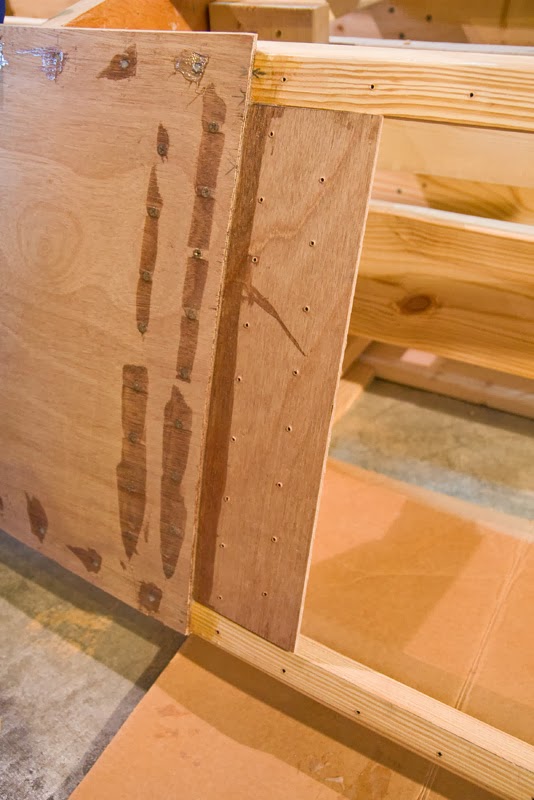I prepared for this on a Saturday afternoon, removing all of the screws and setting aside the planking. That sounds simple enough, until you take in to consideration that’s roughly 80 screws, all driven (and removed) by hand. I don’t bother with the power screwdriver anymore... the silicon bronze screw heads are simply too soft.
 |
| Planking removed, waiting for epoxy. |
 |
| The boat framework, waiting for epoxy. |
 |
| Stem & bow... drilled and ready. |
 |
| Drilled holes along the upper part of the chine log. |
 |
| The port side butt block, waiting for the planking. |
On Sunday, I launched into the task of attaching the planking on for good. I had everything staged: Mixing cups for 2 batches of epoxy, kitchen scale, plenty of Silvertip Gel Magic on-hand, mixing sticks, chip brushes, an awl for initial alignment of screw holes, screwdriver, rag, putty knife, extra latex gloves, and of course... plenty of clamps.
 |
| Kitchen scale, epoxy & application tools ready-to-go. |
After my previous experience with having to mix a second batch of epoxy unexpectedly, this time I pre-planned to mix two batches: One for the framework, one for the plywood. This worked out nicely, with a minimum amount of waste.
First, I removed the remainder of the forward supports for the construction form. It would be difficult to access all the screws to do this after the planking was on. If I didn’t remove it now, I wouldn’t be able to take the hull off of the form later. What an unpleasant discovery that would be.
Next, I lightly sanded all the mating surfaces to remove the “rim” around all the holes that I drilled. I wiped the sawdust off of all the surfaces, and mixed the first batch of epoxy. After applying that to the butt block, sheer clamp, chine log, forward frame, and stem, I mixed the second batch and applied it, (globbed it on), to the plywood. Then, I clamped the plywood roughly into position and aligned the first couple of holes with the awl. I then drove a couple of screws, and satisfied with the alignment, clamped down the rest of the plywood. Then I drove the rest of the screws.
Once that was done, I used the putty knife to scrape away excess epoxy where possible. I used some of the excess to fill screw holes & threads.
When working with epoxy, I wear two layers of disposable latex gloves. I change the outer layer frequently to reduce mess on tools, etc.
The whole process went very smoothly, and took roughly two hours.
 |
| The rest of the port side planking, finally attached. |
 |
| Butt joint, after completion. |
 |
| The port side planking — glued, screwed and clamped at the stem. |
The next steps will be to fair the overhanging edges of the planking down to the chines, and to add a layer of 1/4” Meranti onto the transom. After that, a little more encapsulating work on some small inner parts. Then I can start planking the bottom.
0 komentar:
Posting Komentar